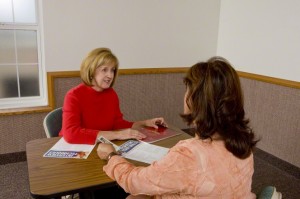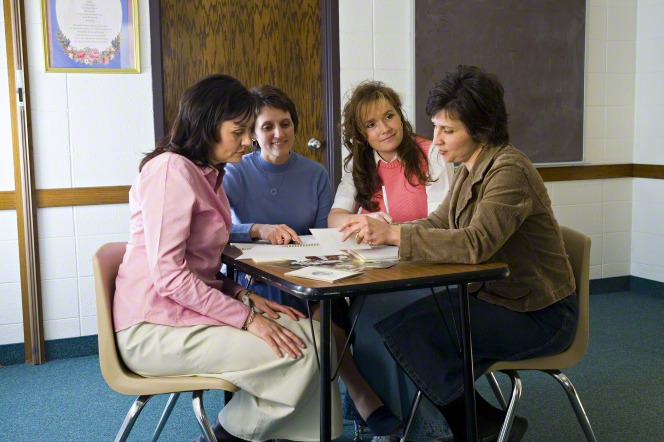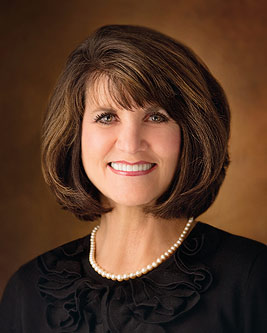 When people learn that Mormon women do not have the priesthood, they often presume that means they can’t do anything but show up for services and listen. This is not at all the case. Mormon is a nickname sometimes given to members of The Church of Jesus Christ of Latter-day Saints and, just as Jesus used women in very important roles in His ministry, He continues to use them in important ways today.
When people learn that Mormon women do not have the priesthood, they often presume that means they can’t do anything but show up for services and listen. This is not at all the case. Mormon is a nickname sometimes given to members of The Church of Jesus Christ of Latter-day Saints and, just as Jesus used women in very important roles in His ministry, He continues to use them in important ways today.
Professional ministers generally have four main areas of responsibility: lead the congregation, carry out worship services, (giving the prayers and sermons), counsel parishioners who are facing difficult situations, and maintain and improve their knowledge of their religion. Let’s use those four areas of responsibility to evaluate what Mormon women do in their church. Keep in mind that in Mormonism, the religious leaders of a congregation are not paid and are not fulltime. The bishop, who is the equivalent of the pastor or minister in most churches, serves only for about five years and does not attend a formal education program in order to be qualified. He, like other Mormon lay clergy, continues in his paid vocation outside the functions of the Church while he serves.
Ministers Carry Out the Worship Services
If you visit a Mormon worship service, you will note that a man conducts the meeting. This will be the bishop or one of his two counselors. Counselors advise the bishop and assist in carrying out the work of the congregation, which is called a ward. The three men rotate the responsibility to conduct, but the bishop always presides unless someone with higher authority is present.
However, people don’t come to a service to listen to the person conducting the meeting. This person is welcoming the congregation, outlining what will happen in the meeting, and making announcements.
The rest of the meeting is carried out by ordinary church members. You might be greeted by someone who is handing out programs or just shaking hands of those who enter, watching for newcomers who may need special attention. When it is time for the Sacrament (communion) to be passed, boys and young men handle all of that responsibility. The piano is played by a member of the congregation, not a paid pianist, and the music is conducted by a congregation member as well.
Even the prayer is given by congregation members, who are normally invited to do so just before the meeting begins. Both men and women can be asked to give the prayers, and even teenagers who are twelve or older may do so.
The sermons, of course, are the part most people think about when they consider a worship service. While in most churches, the minister writes and gives the sermon each week, in a Mormon service, anyone twelve and older can be asked to give it. Most do so about once a year, since each meeting contains brief sermons given by two to four people—often two teenagers and two adults. In congregations that do not have many teenagers, adults usually speak for about twenty minutes. If teenagers are included, the teens speak for five minutes each and the adults fill the remaining time. Once a year the children do the service, but on other weeks, the children also give prayers and sermons during their children’s classes. Small children, beginning at age three, give sermons for two and a half minutes and are helped by a parent if they need help. Mormons call sermons ‘talks.’
We can see that in a Mormon service, Mormon women easily fill most of the first duty of a minister. They pray and give sermons.
Ministers Counsel Parishioners Who are Facing Trials
 One role of a bishop is to counsel people who are having problems or who have committed serious sins. While sins do need to be handled through a bishop, counseling is not exclusive to bishops. Many Relief Society presidents also find themselves counseling. The Relief Society is the official women’s auxiliary for the Church. The president is always a woman and many women feel more comfortable talking to her about problems. The leader of the teenage girls, as well as all their instructors and leaders, often find themselves counseling their students, who prefer to take everyday problems to a trusted leader they know well.
One role of a bishop is to counsel people who are having problems or who have committed serious sins. While sins do need to be handled through a bishop, counseling is not exclusive to bishops. Many Relief Society presidents also find themselves counseling. The Relief Society is the official women’s auxiliary for the Church. The president is always a woman and many women feel more comfortable talking to her about problems. The leader of the teenage girls, as well as all their instructors and leaders, often find themselves counseling their students, who prefer to take everyday problems to a trusted leader they know well.
When I served as the compassionate service leader in the Relief Society, responsible for organizing any service needs of the congregation, I often had women call me when they needed someone to talk to or to advise them. This was because I was often the person on their doorstep when a family member was very ill or had died, when there was a food need, or when another crisis occurred. After receiving comfort from me, they often felt comfortable enough to come to me for further advice. As a very young part-time missionary, I was surprised to find women, even much older women, asking me for advice simply because of my position.
And finally, Mormon women are all visiting teachers. They are assigned several women to visit monthly and to develop a friendship with. When a Mormon woman wants advice or comfort, she most often calls her visiting teacher first, knowing this woman is especially assigned to help her in any way she can.
The unique structure of the Church, which makes all members responsible for the work of the Church, leads Mormon women to find themselves counseling and comforting on a regular basis.
Ministers Lead the Congregation
 The bishop has responsibility for the entire congregation. However, as was mentioned before, Mormons divide the work among all the members of the Church. This gives women tremendous opportunities to lead. Most women will find themselves periodically in positions of leadership over one of three organizations in a congregation—the children’s organization, the organization for teenage girls, and the Relief Society for women. There are other leadership positions that are not assigned by gender.
The bishop has responsibility for the entire congregation. However, as was mentioned before, Mormons divide the work among all the members of the Church. This gives women tremendous opportunities to lead. Most women will find themselves periodically in positions of leadership over one of three organizations in a congregation—the children’s organization, the organization for teenage girls, and the Relief Society for women. There are other leadership positions that are not assigned by gender.
This leadership goes all the way to the international level. Three women oversee each of these organizations for the entire world, establishing them to lead more people than most CEOs in the corporate world.
Learn about Mormon international leaders.
While working under the direction of the priesthood, they are generally given a great deal of autonomy in their work. I have never had the priesthood stop me from doing anything that wasn’t against the rules of the Church—and, of course, I have no desire to break the rules while doing my work.
Ministers Maintain and Increase Their Knowledge of Their Faith
 When Jesus visited Mary and Martha, it created a bit of strife. Martha worked hard to prepare a special meal for their honored guest. However, Mary ignored the work and sat at the Savior’s feet. When Martha tried to get Jesus to get Mary to help, he was gentle and kind. He praised her for her great service and hard work, but also praised Mary for wanting to learn the gospel. At that particular moment, Mary was making the better choice. Jesus didn’t care about a fancy meal; He cared about teaching the gospel.
When Jesus visited Mary and Martha, it created a bit of strife. Martha worked hard to prepare a special meal for their honored guest. However, Mary ignored the work and sat at the Savior’s feet. When Martha tried to get Jesus to get Mary to help, he was gentle and kind. He praised her for her great service and hard work, but also praised Mary for wanting to learn the gospel. At that particular moment, Mary was making the better choice. Jesus didn’t care about a fancy meal; He cared about teaching the gospel.
Jesus demonstrated that women can be both domestic and scholarly and that both are to be praised. The unusual structure of Mormonism strongly encourages turning women into religious scholars. Because they change their church responsibilities often, they have many opportunities to study the gospel and to teach to a variety of audiences. In addition, they give sermons, which require research and deep thought about the assigned topic. Because of this, Mormons of both genders tend to be very knowledgeable in their faith. They have an extensive religious education program and nearly everyone participates in it. In most churches, the majority of adults will leave after the worship service, but Mormons hold church for three hours and most people stay the entire time—in part because so many of them have responsibilities during that time. In addition, teenagers attend a class on school days that teaches religion in a more academic manner,
fittingly called “Seminary,” and college students also attend school day religion classes at a high level. Many congregations also have classes during the week for women who want to study the scriptures in more depth. Extensive self-study materials are available online.
Mormonism is Not a Passive Faith
In most churches, worship is a passive activity. Worshipers show up, listen, and go home. A few might have church work to do, but most do not. Seldom do members of churches pray aloud in the congregation or give a sermon.
Mormon women do all those things. There are more Mormon women giving sermons on a given Sunday than there probably are in the entire world of other churches. Both Mormon women and Mormon men have more opportunities than the average church-goer to minister to others.
So, to answer the question asked by the article: Yes, Mormon women do indeed minister.
About Terrie Lynn Bittner
The late Terrie Lynn Bittner—beloved wife, mother, grandmother, and friend—was the author of two homeschooling books and numerous articles, including several that appeared in Latter-day Saint magazines. She became a member of the Church at the age of 17 and began sharing her faith online in 1992.








As an adult convert to The Church of Jesus Christ of Latter-day Saints, I have felt myself grow in many abilities due to the responsibilities I have been asked to fulfill as a woman in the Church. I am doing things now that my younger self only dreamed of doing!